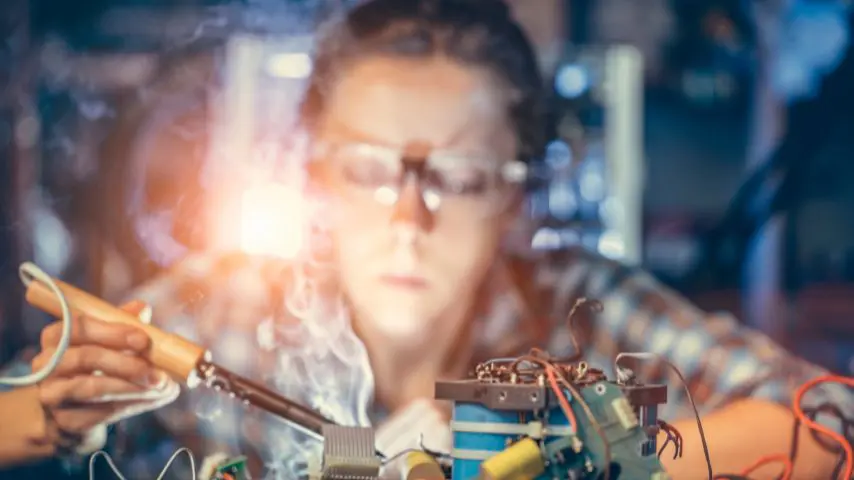6 Questions with Magic Leap's Cathy Hackl
6 Questions with Magic Leap's Cathy Hackl


Cathy Hackl from Magic Leap is a futurist and an advocate for AR, VR, and spatial computing as tools for the future.
Augmented reality headsets combine the best of natural vision and digital information. AR can connect workers in remote locations to field experts, train them in new skills, and walk technicians through a repair. It provides a mobile and intuitive way for engineers to interact with sensor data, digital twins, and their physical counterparts. Speaking with Cathy Hackl from Magic Leap’s Enterprise Partner Marketing, we learn how the company’s spatial computer not only provides an enhanced view of the reality but responds directly to the user.
Q1: What is Magic Leap and how it is different from other AR headsets?
C.H: Magic Leap One is a spatial computer that lets you see and interact with digital content in the world around you. It uses spatial computing, which is a new form of computing that combines artificial intelligence and computer vision to blend that digital content in your reality seamlessly. It’s a computer that can see what you see and has the power to learn. It’s a lightweight wearable computing device that can place content in your reality by using eye-tracking and head pose.
Learn More About: October 2019 Manufacturing Special Report: Augmented Reality
What makes us different is that our system senses your environment by meshing your space. The system also senses you and allows for digital objects to exist realistically in your surroundings. Content is spatially aware: If I throw a digital ball and it hits a wall, the ball will bounce back because it understands there’s a wall there. This awareness of the user and space incorporates sensors, IoT, and AI in a much more profound way.
Q2: What are the main uses for the headset and what industry is it geared towards?
C.H: Magic Leap is more than just hardware; we are a platform for businesses. We work with clients to provide real-world solutions across enterprise verticals like manufacturing, AEC, automotive, entertainment, healthcare, retail, and beyond. Our enterprise platform enables businesses to roll out devices to employees in a secure and easy-to-manage way, as well as help clients deploy the right solutions for their needs ranging from productivity, training, and beyond.
Currently, we are helping clients reduce the time it takes to train employees and allow workers to be more productive, whether it’s designing a building or modeling a car. We are working with clients across all verticals and helping these companies’ future-proof their business models in a new digital era.
Q3: How will AR impact workforce collaboration and design work?
C.H: We are seeing clients having significant success across three universal use cases: Communication, collaboration, and co-presence; Learning and training; and 3D Visualization.
Watch Our Video On: How AR Helps Manufacturing
One of the ways that spatial computing is being used in manufacturing, for example, is to overlay data over an assembly line and help a worker get upskilled quicker, while also helping that worker identify potential problems in the supply chain before they happen. It allows a worker to start training on a piece of machinery, even if the worker is not in the same location as that item. The applications for spatial computing are endless and are greatly impacting business operations.
Q4: Can an AR headset be used for training or remote assistance purposes?
C.H: It most definitely can and is being used across enterprise verticals. One example is a facilities manager using Magic Leap One to record a step-by-step training plan within the real context of the warehouse. They can add notes, voice recordings, directions, and metadata on the shelf and a new employee can put the headset on and train seeing this content, which is persistent. So, when you leave a room and come back, that content is still there. This accelerates the time of the cost of training an employee and greatly benefits the company.
Q5: What problems do people have with AR technology?
C.H: I would say the biggest challenge we face is education. That’s why part of my role as part of the enterprise marketing team is helping clients understand how spatial computing can have a positive impact on their business processes and educate them on what our technology can do and its impact on ROI. When our clients embrace our emerging technology platform and move beyond just having a proof of concept for their innovation center and fully engage in a pilot program using our technology, that’s when we see the most impact.
View Our Infographic On: The Evolution of the Modern Factory
Q6: What are the biggest benefits of introducing AR into a work setting?
C.H: The most significant benefits of introducing spatial computing into a work setting are that companies can increase efficiencies or productivity as well as optimizing processes, and this benefits the company’s bottom line as well as the worker who can get upskilled a lot faster and can be more productive.
Carlos M. Gonzalez is special projects editor.
Q1: What is Magic Leap and how it is different from other AR headsets?
C.H: Magic Leap One is a spatial computer that lets you see and interact with digital content in the world around you. It uses spatial computing, which is a new form of computing that combines artificial intelligence and computer vision to blend that digital content in your reality seamlessly. It’s a computer that can see what you see and has the power to learn. It’s a lightweight wearable computing device that can place content in your reality by using eye-tracking and head pose.
Learn More About: October 2019 Manufacturing Special Report: Augmented Reality
What makes us different is that our system senses your environment by meshing your space. The system also senses you and allows for digital objects to exist realistically in your surroundings. Content is spatially aware: If I throw a digital ball and it hits a wall, the ball will bounce back because it understands there’s a wall there. This awareness of the user and space incorporates sensors, IoT, and AI in a much more profound way.
Q2: What are the main uses for the headset and what industry is it geared towards?
C.H: Magic Leap is more than just hardware; we are a platform for businesses. We work with clients to provide real-world solutions across enterprise verticals like manufacturing, AEC, automotive, entertainment, healthcare, retail, and beyond. Our enterprise platform enables businesses to roll out devices to employees in a secure and easy-to-manage way, as well as help clients deploy the right solutions for their needs ranging from productivity, training, and beyond.
Currently, we are helping clients reduce the time it takes to train employees and allow workers to be more productive, whether it’s designing a building or modeling a car. We are working with clients across all verticals and helping these companies’ future-proof their business models in a new digital era.
Q3: How will AR impact workforce collaboration and design work?
C.H: We are seeing clients having significant success across three universal use cases: Communication, collaboration, and co-presence; Learning and training; and 3D Visualization.
Watch Our Video On: How AR Helps Manufacturing
One of the ways that spatial computing is being used in manufacturing, for example, is to overlay data over an assembly line and help a worker get upskilled quicker, while also helping that worker identify potential problems in the supply chain before they happen. It allows a worker to start training on a piece of machinery, even if the worker is not in the same location as that item. The applications for spatial computing are endless and are greatly impacting business operations.
Q4: Can an AR headset be used for training or remote assistance purposes?
C.H: It most definitely can and is being used across enterprise verticals. One example is a facilities manager using Magic Leap One to record a step-by-step training plan within the real context of the warehouse. They can add notes, voice recordings, directions, and metadata on the shelf and a new employee can put the headset on and train seeing this content, which is persistent. So, when you leave a room and come back, that content is still there. This accelerates the time of the cost of training an employee and greatly benefits the company.
Q5: What problems do people have with AR technology?
C.H: I would say the biggest challenge we face is education. That’s why part of my role as part of the enterprise marketing team is helping clients understand how spatial computing can have a positive impact on their business processes and educate them on what our technology can do and its impact on ROI. When our clients embrace our emerging technology platform and move beyond just having a proof of concept for their innovation center and fully engage in a pilot program using our technology, that’s when we see the most impact.
View Our Infographic On: The Evolution of the Modern Factory
Q6: What are the biggest benefits of introducing AR into a work setting?
C.H: The most significant benefits of introducing spatial computing into a work setting are that companies can increase efficiencies or productivity as well as optimizing processes, and this benefits the company’s bottom line as well as the worker who can get upskilled a lot faster and can be more productive.
Carlos M. Gonzalez is special projects editor.



